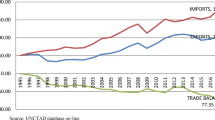Abstract
Beyond the existing forms of East-West cooperation in Europe such as economic assistance, loans, joint ventures and association agreements, both sides are looking for suitable ways of establishing more institutionalized relations. Already existing institutions, membership of which could be offered to the new market economies, are EFTA, the European Economic Area (EEA) and the EU. This article discusses the effects of membership for both eastern and western countries in the light of their differing interests.
Similar content being viewed by others
References
UN Economic Commission for Europe: Economic Survey of Europe in 1993–1994, New York 1994, pp. 86 ff.
Ibid., UN Economic Commission for Europe: Economic Survey of Europe in 1993–1994, New York 1994, pp. 7 f. and 74 ff.
Ibid., UN Economic Commission for Europe: Economic Survey of Europe in 1993–1994, New York 1994, pp. 118 f.
For details of production and export structures in particular new market economies, see UN Commission for Europe, op. cit. Economic Survey of Europe in 1993–1994, New York 1994, pp. 58 ff.
Ibid. For details of production and export structures in particular new market economies, see UN Commission for Europe, op. cit. Economic Survey of Europe in 1993–1994, New York 1994, pp. 4 and 71.
A critical view of the European model and the tendency to measure its success in terms of the queue of countries knocking at the door, discussing some negative effects of EU expansion for Europe as a whole, is given by Gerda Zellentin: Die Schimäre des europäischen Superstaats, in: Blätter für deutsche und internationale Politik, No. 6, 1992, pp. 698–708, esp. p. 706 where she focuses on the negative effects of the EU such as over-production, environmental destruction and a loss of democracy, as undesirable development perspectives for the new market economies.
All details on the absolute value of GDP and on growth rates are taken from United Nations: World Economic and Social Survey, New York 1994, pp. 259 ff.
For the fundamentals, see Hansjörg Herr, Andreas Westphal: Die Transformation von Planwirtschaften in Geldwirtschaften—Ökonomische Kohärenz, Mindestschwelle der Transformation, außenwirtschaftliche Strategien, in: discussion papers des WZB, FSI, 9/1990.
Jürgen Stehn: Stufen einer Osterweiterung der Europäischen Union, in: Die Weltwirtschaft, No. 2, 1994, pp. 212 ff. The author's own calculations which follow are based on official EU statistics (Eurostat 1995).
For an explanation of negative and positive integration in the EC/EU and a critical reflection on the limits to positive integration, see Fritz. W. Scharpf: Mehrebenenpolitik im vollendeten Binnenmarkt, in: MPIFG discussion papers, No. 4, 1994.
This view is shared by Kai Hirschmann, Elsbieta Hirschmann and Otto F. Bode: Internationalisierung und die osteuropäische institutionelle Integration, in: ditto (eds.): Weltwirtschaftliche Anpassung und Öffnung der osteuropäischen Reformstaaten. Transformationskosten—Handlungsstrategien—Ökologische Modernisierung—Konsumentenverhalten—Humankapital, Berlin 1993, pp. 7–15.
The same view is taken in Kai Hirschmann, Elsbieta Hirschmann, Otto F. Bode, op. cit. Internationalisierung und die osteuropäische institutionelle Integration, in: ditto (eds.): Weltwirtschaftliche Anpassung und Öffnung der osteuropäischen Reformstaaten. Transformationskosten—Handlungsstrategien—Ökologische Modernisierung—Konsumentenverhalten—Humankapital, Berlin 1993, p. 14.
Author information
Authors and Affiliations
Rights and permissions
About this article
Cite this article
Bauer, P. East-West economic cooperation. Intereconomics 30, 285–293 (1995). https://doi.org/10.1007/BF02926390
Issue Date:
DOI: https://doi.org/10.1007/BF02926390




